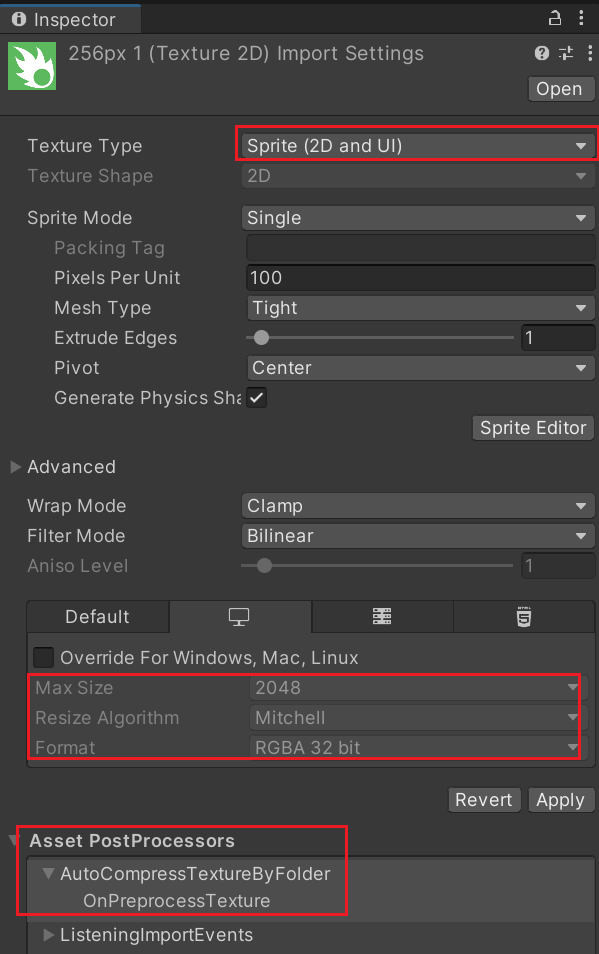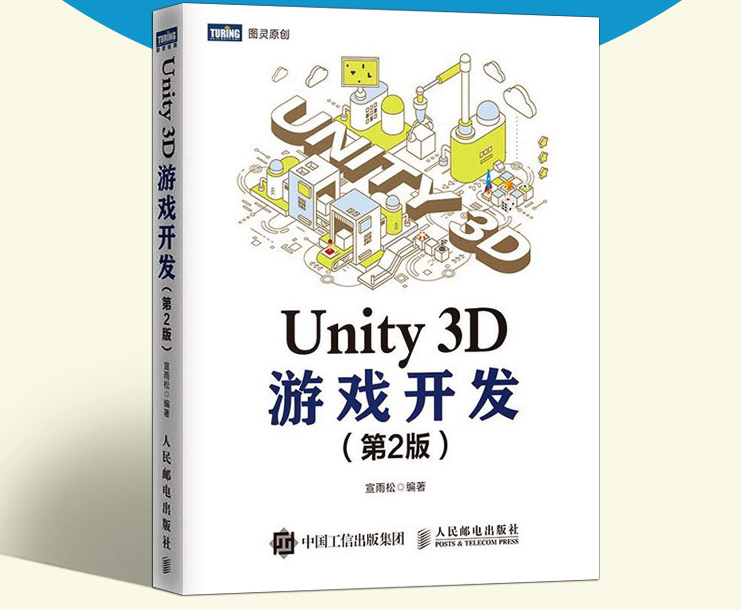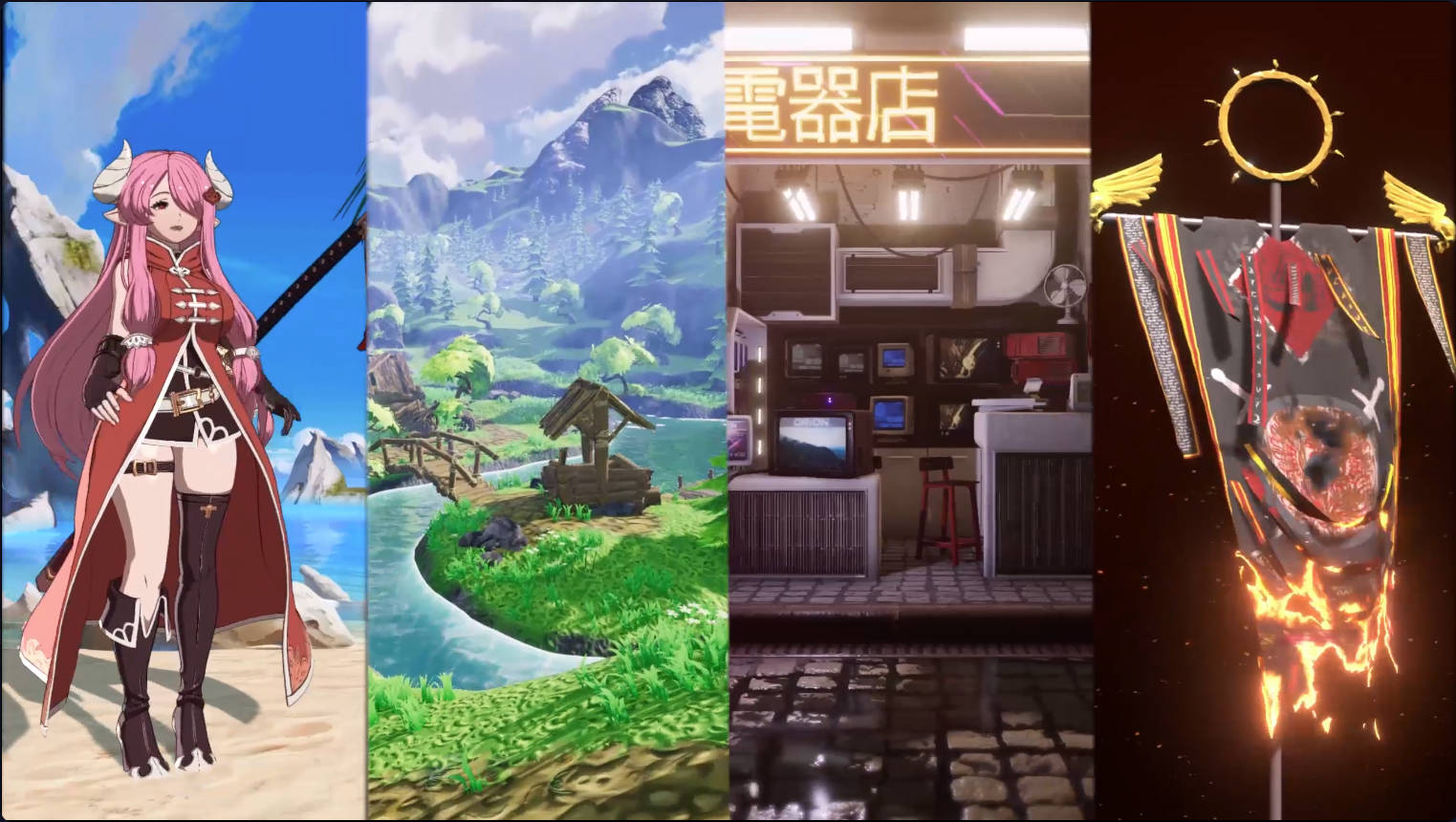游戏中的资源是海量的,这就带来了新的问题,大量的资源格式需要设置,比如贴图格式、模型格式、音频格式和文件格式等。我们需要结合自动化来管理资源。另外,游戏打包这一步也需要自动化。例如,每次打包前,需要对包体做一些修改,如果全都手动操作,就非常麻烦了。这一章学习Unity自动化接口。
资源导入
在Unity中导入资源后,都可以通过设置参数来直接修改它的格式,而引擎会重新压缩资源。游戏中的大量资源都是美术人员或者策划人员导入的,这个过程很容易设置成错误的资源类型,或者由于没有设置成默认的效率不高的资源类型。为了避免出现这种低级错误,我们要做的就是帮他们手动设置。
监听导入事件
资源导入后,Unity会根据设置信息自动压缩。而导入事件又分两种:压缩前的时间和压缩后的事件。如果需要修改导入参数,那么就可以监听压缩前的事件来修改它,后面就会自动执行导入操作了。如果想等导入结束后生成点什么对象,可以监听导入后事件。
继承AssetPostprocessor后,就可以监听它们的事件了
相关参考,拓展编辑器一监听资源事件:Unity游戏开发拓展编辑器1
1
2
3
4
5
6
7
8
9
10
11
12
13
14
15
16
17
18
19
20
21
22
23
24
25
26
27
28
29
30
31
32
33
34
35
36
37
38
39
40
41
42
43
44
45
46
47
48
49
50
51
| using UnityEngine;
using UnityEditor;
public class ListeningImportEvents : AssetPostprocessor
{
void OnPreprocessAudio()
{
AudioImporter audioImporter = (AudioImporter)assetImporter;
}
void OnPreprocessAnimation()
{
ModelImporter modelImporter = (ModelImporter)assetImporter;
}
void OnPreprocessModel()
{
ModelImporter modelImporter = (ModelImporter)assetImporter;
}
void OnPreprocessTexture()
{
TextureImporter textureImporter = (TextureImporter)assetImporter;
}
void OnPostprocessAudio(AudioClip clip)
{
Debug.Log(AssetDatabase.GetAssetPath(clip));
}
void OnPostprocessModel(GameObject g)
{
Debug.Log(AssetDatabase.GetAssetPath(g));
}
void OnPostprocessMaterial(Material material)
{
Debug.Log(AssetDatabase.GetAssetPath(material));
}
void OnPostprocessSprites(Texture2D texture,Sprite[] sprites)
{
Debug.Log("Sprites: " + sprites.Length);
}
void OnPostprocessTexture(Texture2D texture)
{
Debug.Log("Texture2D:(" + texture.width + "x" + texture.height + ")");
}
}
|
资源的种类有很多,在上述代码中,我们可以分别监听资源导入前以及导入后的事件,导入前事件用于设置资源的压缩参数,而导出后事件可以修改最终保存的资源文件
自动设置贴图压缩格式
比如,项目有两个目录:一个是UI、另一个是Texture。当贴图拖入UI目录下时,自动设置贴图的类型:而当贴图拖入Texture目录时,则自动设置普通模型使用的贴图。
1
2
3
4
5
6
7
8
9
10
11
12
13
14
15
16
17
18
19
20
21
22
23
24
25
26
27
28
29
30
31
32
33
34
35
36
37
38
39
40
41
42
43
44
45
46
47
48
49
50
51
52
53
54
55
56
57
58
59
| using UnityEditor;
public class AutoCompressTextureByFolder : AssetPostprocessor
{
void OnPreprocessTexture()
{
TextureImporter textureImporter = (TextureImporter)assetImporter;
if(textureImporter.assetPath.Contains("UI"))
{
textureImporter.textureType = TextureImporterType.Sprite;
textureImporter.mipmapEnabled = false;
TextureImporterPlatformSettings standaloneSettings = new TextureImporterPlatformSettings();
standaloneSettings.name = "Standalone";
standaloneSettings.maxTextureSize = 2048;
standaloneSettings.format = TextureImporterFormat.RGBA32;
textureImporter.SetPlatformTextureSettings(standaloneSettings);
TextureImporterPlatformSettings iPhoneSettings = new TextureImporterPlatformSettings();
iPhoneSettings.name = "iPhone";
iPhoneSettings.maxTextureSize = 2048;
iPhoneSettings.format = TextureImporterFormat.RGBA32;
iPhoneSettings.compressionQuality = 100;
iPhoneSettings.allowsAlphaSplitting = true;
textureImporter.SetPlatformTextureSettings(iPhoneSettings);
TextureImporterPlatformSettings AndroidSettings = new TextureImporterPlatformSettings();
AndroidSettings.name = "Android";
AndroidSettings.maxTextureSize = 2048;
AndroidSettings.format = TextureImporterFormat.RGBA32;
AndroidSettings.allowsAlphaSplitting = true;
textureImporter.SetPlatformTextureSettings(AndroidSettings);
}
else if(textureImporter.assetPath.Contains("Texture"))
{
textureImporter.textureType = TextureImporterType.Default;
textureImporter.mipmapEnabled = true;
TextureImporterPlatformSettings standaloneSettings = new TextureImporterPlatformSettings();
standaloneSettings.name = "Standalone";
standaloneSettings.maxTextureSize = 2048;
standaloneSettings.format = TextureImporterFormat.DXT5;
textureImporter.SetPlatformTextureSettings(standaloneSettings);
TextureImporterPlatformSettings iPhoneSettings = new TextureImporterPlatformSettings();
iPhoneSettings.name = "iPhone";
iPhoneSettings.maxTextureSize = 2048;
iPhoneSettings.format = TextureImporterFormat.ASTC_4x4;
iPhoneSettings.compressionQuality = 100;
iPhoneSettings.allowsAlphaSplitting = true;
textureImporter.SetPlatformTextureSettings(iPhoneSettings);
TextureImporterPlatformSettings AndroidSettings = new TextureImporterPlatformSettings();
AndroidSettings.name = "Android";
AndroidSettings.maxTextureSize = 2048;
AndroidSettings.format = TextureImporterFormat.ETC2_RGB4;
AndroidSettings.allowsAlphaSplitting = true;
textureImporter.SetPlatformTextureSettings(AndroidSettings);
}
}
}
|

当UI或者Texture文件夹中的资源是从Project窗口内别的目录移动过来的时候,我们在移动过来的资源上右键——Reimport,即可重新执行导入流程,即时更新资源设置信息。
自动设置模型
模型是FBX文件,我们可以监听模型的导入事件,自动设置它的一些参数。当导入完成后,会自动生成prefab文件。
当模型拖入Project视图中,就会立刻在根目录下生成和它同名的Prefab。
1
2
3
4
5
6
7
8
9
10
11
12
13
14
15
16
17
| using UnityEngine;
using UnityEditor;
public class AutoGenerateFBXPrefab : AssetPostprocessor
{
void OnPreprocessModel()
{
ModelImporter modelImporter = (ModelImporter)assetImporter;
modelImporter.animationType = ModelImporterAnimationType.Generic;
}
void OnPostprocessModel(GameObject g)
{
PrefabUtility.SaveAsPrefabAsset(g,string.Format("Assets/{0}.prefab",g.name));
}
}
|
禁止模型生成材质文件
如果美术人员在三维软件中指定了模型的材质,那么在导入模型的时候,就会自动生成这个材质。
如果有两个模型,它们的FBX包含了相同的引用材质,但是有一个模型在Unity中又重新指定了不同的材质,将这两个模型设为prefab,然后再打包成AssetBundle,其中的在Unity中使用新材质的模型会因为自己本身的FBX信息将旧的材质再打包一遍,所以可以考虑关闭自动导入材质
1
2
3
4
5
6
7
8
9
10
11
| using UnityEngine;
using UnityEditor;
public class StopGenerateMaterial : AssetPostprocessor
{
void OnPreprocessModel(){
ModelImporter modelImporter = (ModelImporter)assetImporter;
modelImporter.importMaterials = false;
}
}
|
删除移动资源事件
导入资源不一定能满足所有要求。很多时候,资源很可能只是再内部移动一个位置,比如从一个目录移动到另一个目录下,此时我们可以监听资源删除和移动的事件
和 AssetModificationProcessor不同,AssetPostprocessor.OnPostprocessAllAssets方法是在所有资源完成移动和删除之后调用的,可以任意调用AssetDataBase的API,而前者不能
1
2
3
4
5
6
7
8
9
10
11
12
13
14
15
16
17
18
19
20
21
| using UnityEngine;
using UnityEditor;
public class AssetPostModify : AssetPostprocessor
{
static void OnPostprocessAllAssets(string[] importedAssets,string[] deletedAssets,string[] movedAssets,string[] movedFromAssetPaths)
{
foreach (string str in importedAssets)
{
Debug.LogFormat("新导入的资源:{0}",str);
}
foreach (string str in deletedAssets)
{
Debug.LogFormat("删除的资源:{0}",str);
}
for (int i = 0; i < movedAssets.Length; i++)
{
Debug.LogFormat("移动资源位置 : from: {0} to :{1}",movedFromAssetPaths[i],movedAssets[i]);
}
}
}
|
我们可以通过判断资源路径来特殊处理工程中的某些资源
选择性自动设置
通常情况下,我们会设置某一个文件夹下的资源格式保持一致。但某些时候,一些相同的资源可能并不支持此格式,比如说某些贴图不支持设置压缩格式,如果另外设置新的文件夹,那么就需要修改程序的加载代码。我们可以设置一个导入的默认项,这样就能满足90%的情况,剩下的10%可以由美术人员自己来把握。
例如,以移动平台为例,Android下贴图导入自动设置成ETC2压缩格式,如果某张图确实无法用ETC2压缩,美术人员就自行勾选RGBA32,这样程序的逻辑完全不受影响了
1
2
3
4
5
6
7
8
9
10
11
12
13
14
15
16
17
18
19
20
| using UnityEditor;
public class OptionalTextureSettings : AssetPostprocessor
{
void OnPreprocessTexture()
{
TextureImporter textureImporter = (TextureImporter)assetImporter;
TextureImporterPlatformSettings textureImporterPlatformSettings = textureImporter.GetPlatformTextureSettings("Android");
if(textureImporterPlatformSettings.format != TextureImporterFormat.ETC2_RGBA8 &&
textureImporterPlatformSettings.format != TextureImporterFormat.RGBA32){
TextureImporterPlatformSettings AndroidSettings = new TextureImporterPlatformSettings();
AndroidSettings.name = "Android";
AndroidSettings.maxTextureSize = 2048;
AndroidSettings.format = TextureImporterFormat.ETC2_RGBA8;
AndroidSettings.allowsAlphaSplitting = true;
textureImporter.SetPlatformTextureSettings(AndroidSettings);
}
}
}
|
主动设置
前面的代码都是依赖资源导入的回调来做的操作,有时并不需要导入资源而是主动去设置某个资源格式。
1
2
3
4
5
6
7
8
9
10
11
12
13
14
15
16
17
18
19
20
21
22
23
24
| using UnityEditor;
public class InitiativeTextureSettings : AssetPostprocessor
{
[MenuItem("Assets/SetTextureFormat/RGBA32",false,-1)]
static void SetTextureFormat()
{
if(Selection.assetGUIDs.Length > 0)
{
AssetImporter importer = AssetImporter.GetAtPath(AssetDatabase.GetAssetPath(Selection.activeGameObject));
if(importer is TextureImporter)
{
TextureImporterPlatformSettings standaloneSettings = new TextureImporterPlatformSettings();
standaloneSettings.name = "Standalone";
standaloneSettings.maxTextureSize = 2048;
standaloneSettings.format = TextureImporterFormat.RGBA32;
(importer as TextureImporter).SetPlatformTextureSettings(standaloneSettings);
importer.SaveAndReimport();
}
}
}
}
|

待保存状态
只有对象变成Dirty后,才可以进行保存。如果主动修改场景中的任意对象,场景就会变成dirty状态,此时场景旁边就会出现一个*符号。
有时通过代码设置游戏对象或者对象身上的序列化信息时,很可能不会造成dirty状态,Unity不会进行保存,所以必要时应该通过代码强制设置dirty状态。
1
2
3
4
5
6
7
8
9
10
11
12
13
14
15
16
17
| using UnityEngine;
using UnityEditor;
using UnityEditor.SceneManagement;
public class MakeSceneModified : AssetPostprocessor
{
[MenuItem("Assets/SetSceneDirty",false)]
static void SetSceneDirty()
{
EditorSceneManager.MarkSceneDirty(EditorSceneManager.GetActiveScene());
EditorUtility.SetDirty(AssetDatabase.LoadAssetAtPath<GameObject>("Assets/Cube.prefab"));
}
}
|
Unity内部有很多MenuItem,使用EditorApplication.ExecuteMenuItem()来快捷应用
使用下面的代码,快捷选择和复制Project中的对象
1
2
3
4
5
6
7
8
9
10
11
12
13
14
15
16
17
18
| using UnityEngine;
using UnityEditor;
public class ExecuteMenuItemExample
{
[MenuItem("Assets/AutoMenuItem",false)]
static void AutoMenuItem()
{
Selection.activeObject = AssetDatabase.LoadAssetAtPath<Object>("Assets/Scenes/SampleScene.unity");
EditorApplication.ExecuteMenuItem("Edit/Duplicate");
Selection.activeObject = AssetDatabase.LoadAssetAtPath<Object>("Assets/Resources/Cube 1.prefab");
EditorApplication.ExecuteMenuItem("Edit/Duplicate");
}
}
|




